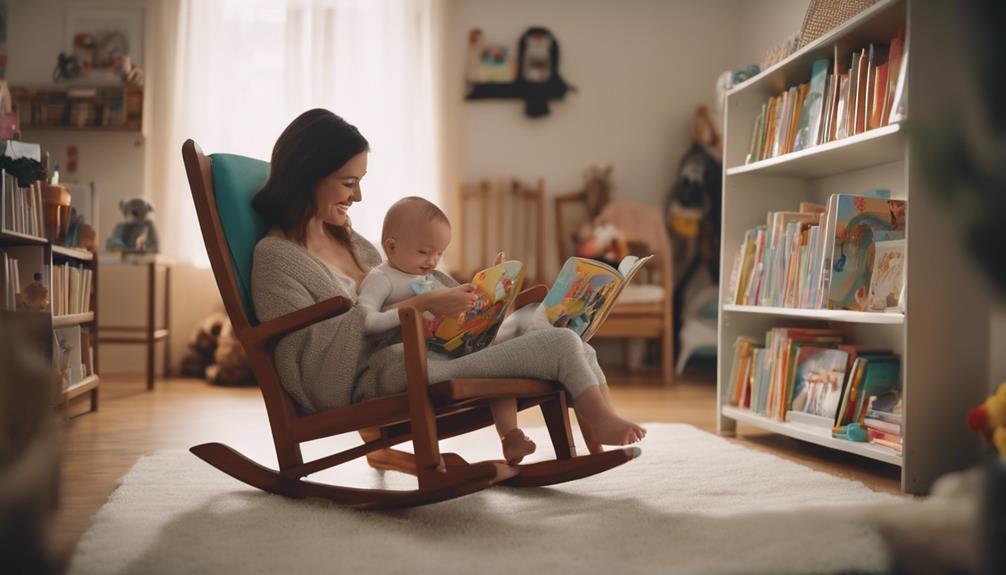The Baby-Sitters Club, founded in 1986 by Ann M. Martin, follows a group of friends in Stoneybrook, captivating young readers. Characters like Kristy, Claudia, and Mary Anne embody teamwork, independence, and positive values. This series tackles themes of friendship, critical thinking, and personal development, imparting valuable life lessons. Through graphic novel adaptations and a Netflix series, it appeals to visual learners and sparks creativity in young minds. Ann M. Martin’s authentic representation of diverse characters draws from her own experiences, connecting readers with relatable narratives. The Baby-Sitters Club goes beyond babysitting tales, instilling enduring moral principles and making a lasting impact.
Key Takeaways
- Fosters love of reading and teaches valuable life lessons.
- Modern graphic novel adaptations engage visual learners effectively.
- Inspires personal growth through relatable character journeys.
- Encourages teamwork, problem-solving, and independence in young readers.
- Vibrant illustrations enhance storytelling and captivate young audiences.
Series Overview
Discover the enchanting world of the Baby-Sitters Club series created by Ann M. Martin in 1986, where suburban friends navigate friendship, entrepreneurship, and family dynamics.
The series consists of a collection of books that follow the adventures of a group of friends who start a babysitting business in Stoneybrook, Connecticut.
This Great series has captured the hearts of young readers for decades, offering engaging storylines that tackle themes of teamwork, problem-solving, and independence.
The Baby-Sitters Club series hasn't only inspired a Netflix original series but has also been adapted into graphic novels.
These graphic adaptations provide a fresh take on the beloved stories, with vibrant illustrations that appeal to a new generation of readers.
The combination of relatable characters, relatable situations, and valuable life lessons has made this series a favorite among both reluctant and avid readers.
Immerse yourself in the world of the Baby-Sitters Club series and experience the timeless appeal of these heartwarming tales.
Characters and Relationships

In the Baby-Sitters Club series, the characters of Kristy, Claudia, Mary Anne, Stacey, and Dawn form a close-knit group that navigates friendships and adventures while running a babysitting business in Stoneybrook, Connecticut.
Mary Anne is known for her shy and thoughtful demeanor, often providing a calm presence within the group. Kristy, as the founder of the club, exhibits strong leadership qualities and a knack for organization. Claudia's creative flair and unique sense of style bring a vibrant energy to the group dynamic.
Stacey's sophistication and maturity contribute to the diverse mix of personalities, adding a level-headed perspective to their escapades. The friendships depicted among these characters showcase loyalty, support, and teamwork, emphasizing the values of communication, empathy, and cooperation in fostering strong relationships.
Readers are drawn to the relatable dynamics and interactions between the babysitters, highlighting themes of acceptance, inclusivity, and personal growth that resonate with young audiences seeking connection and understanding.
Themes and Life Lessons

The Baby-Sitters Club series imparts important moral values through its exploration of themes like friendship, teamwork, and personal growth journeys. Children are exposed to the significance of collaboration, problem-solving, and responsibility as they follow the characters on their adventures.
These life lessons contribute to the positive impact the series has on young readers, fostering not just an appreciation for reading but also a sense of empathy and resilience.
Important Moral Values
Exploring the Baby-Sitters Club series reveals a rich tapestry of important moral values, including friendship, teamwork, responsibility, and problem-solving skills. These values are intricately woven into the stories, providing young readers with valuable life lessons and positive role models to emulate.
Through the adventures of the club members, children learn about empathy, communication, and the significance of supporting one another. The series showcases how individuals can come together to tackle challenges effectively, emphasizing the importance of collaboration and unity.
- Friendship, teamwork, responsibility, and problem-solving skills are central themes in the Baby-Sitters Club series, guiding readers towards understanding the significance of these values in their own lives.
- The stories present relatable scenarios that teach children about overcoming obstacles, handling jealousy, and nurturing independence, imparting practical lessons for personal growth.
- Entrepreneurship, family dynamics, and the influence of positive role models are highlighted, showcasing the power of these elements in shaping young minds and character development.
Friendship and Teamwork
Amidst the adventures of the Baby-Sitters Club series, you witness the profound impact of friendship and teamwork on the characters' journeys. These middle school girls exemplify the power of positive relationships and effective collaboration.
Through the lens of friendship, the series highlights the importance of building strong connections and supporting one another. The theme of teamwork underscores how working together can lead to greater success and achievement.
The strong friendships among the characters serve as a foundation for overcoming challenges and maneuvering through the complexities of adolescence. By showcasing the value of unity and trust, the series imparts valuable life lessons to young readers.
Children are encouraged to appreciate the significance of friendship and teamwork in their own lives, learning how these elements can shape their experiences and help them grow. The Baby-Sitters Club series serves as a reminder of the positive impact that strong friendships and effective teamwork can have on individuals as they face various obstacles and triumphs.
Personal Growth Journeys
Begin an enlightening journey through the personal growth themes and life lessons woven into the Baby-Sitters Club series. The series serves as a platform for young readers to witness the characters' personal growth journeys, providing valuable insights into various aspects of life.
- Positive Role Models: The characters in the Baby-Sitters Club exemplify traits like resilience, empathy, and determination, serving as positive role models for readers to emulate.
- Empowerment: Through the challenges and successes faced by the characters, readers learn about empowerment and the importance of believing in oneself to overcome obstacles.
- Self-Discovery: The series explores themes of self-discovery, encouraging readers to explore their own identities, passions, and strengths alongside the characters in the books.
Impact on Young Readers

The Baby-Sitters Club series has had a significant impact on young readers by fostering a love of reading and teaching valuable life lessons through relatable characters and engaging storytelling.
The modern graphic novel adaptations, with their vibrant illustrations, have particularly resonated with young readers, drawing in visual learners and those who appreciate a visually immersive experience. These adaptations, such as 'Mary Anne Saves the Day', bring the beloved stories to life in a new format, further captivating the audience.
Through the series, readers not only enjoy the entertaining tales of friendship and babysitting adventures but also glean important life lessons on teamwork, problem-solving, independence, and creativity. By following the diverse group of characters as they navigate challenges and triumphs, young readers are inspired to apply these lessons to their own lives.
The impact of The Baby-Sitters Club on its readers extends beyond the pages, influencing how they approach relationships, responsibilities, and personal growth.
Ann M. Martin's Inspiration

Ann M. Martin's inspiration for The Baby-Sitters Club series stemmed from her personal encounters as a teenage babysitter, shaping the foundation of her creative journey.
Through meticulous character development and a dedication to authenticity, Martin crafted a world that resonates with young readers, fostering a sense of connection and relatability.
Her commitment to diverse and realistic portrayals hasn't only sustained the series' popularity but also enriched the storytelling experience for generations of children.
Ann M. Martin's Influence
Drawing from her experiences as a babysitter, Ann M. Martin found inspiration for The Baby-Sitters Club series. The influence of Ann M. Martin on the series is evident through:
- Creating positive role models: Martin's values of friendship, responsibility, and empathy are reflected in the characters, presenting young readers with admirable traits to emulate.
- Developing diverse personalities: The characters in the series showcase a wide range of personalities, allowing readers to identify with different aspects of each character and promoting inclusivity.
- Addressing relevant issues: Through impactful storytelling, Martin tackles relevant issues faced by tweens, such as friendship struggles, family dynamics, and personal growth, providing young readers with a platform to explore and understand these challenges.
Ann M. Martin's commitment to crafting relatable characters, addressing important topics, and nurturing a sense of community within The Baby-Sitters Club has left a lasting impact on readers for generations.
Creative Writing Process
Moreover, Ann M. Martin's creative process for The Baby-Sitters Club series involved weaving real-life elements into relatable and educational storylines, drawing from personal experiences and meticulous research. By basing characters on real people from her life and infusing the series with authenticity, Martin added depth to the characters and plotlines, contributing to the enduring popularity of the books among young readers.
Additionally, Martin's dedication to meticulous research on topics such as diabetes and stroke allowed her to seamlessly incorporate important educational elements into the narrative. The suburban Connecticut setting, reflecting the author's own upbringing, provided a familiar backdrop for the stories, making them more relatable to the audience.
Through a skillful blend of personal experiences, in-depth research, and relatable environments, Ann M. Martin crafted a series that continues to captivate young readers with its engaging and educational content.
Character Development Journeys
In exploring the character development journeys within The Baby-Sitters Club series, you'll find a rich tapestry of diverse personalities and backgrounds reflecting the importance of empathy, understanding, and friendship.
The growth of each character, from Mary Anne to Anne's Bad Luck, showcases the nuances of emotional intelligence and resilience. Ann M. Martin's inspiration from her own upbringing in Princeton, New Jersey, shines through in the relatable struggles and triumphs each character faces.
- Mary Anne's evolution from a shy, reserved individual to a more confident and assertive young woman highlights the power of self-discovery and personal growth.
- Anne's Bad Luck's storyline illustrates the challenges of overcoming adversity and learning to navigate life's obstacles with grace and determination.
The overall character development in The Baby-Sitters Club series encourages readers to embrace empathy, understanding, and the importance of forging strong friendships to overcome life's hurdles.
Evolution of the Series

How has the Baby-Sitters Club series evolved since its inception in 1986? The series has adapted to engage modern readers, especially visual learners, through the release of Baby-Sitters Club Graphix and graphic novels. These updated editions feature vibrant illustrations that bring the beloved characters and their adventures to life in a new way. The incorporation of visual elements not only caters to the preferences of contemporary audiences but also enhances the storytelling experience by providing a more immersive and dynamic reading journey.
| Evolution of the Series | |
|---|---|
| Inception in 1986 | Traditional novels featuring the original stories. |
| Introduction of Graphic Novels | Baby-Sitters Club Graphix and graphic novels released to appeal to visual learners. |
| Modern Readers | Updated editions with contemporary themes to resonate with today's young audience. |
| Netflix Original Show | Adaptation of the series, introducing it to a new generation of viewers. |
| Enduring Legacy | Over 100 novels and continued relevance showcase the series' lasting impact. |
Spin-offs and Adaptations

Spin-offs and adaptations of the Baby-Sitters Club series have extended the beloved stories to new audiences and formats. The series has inspired various adaptations and spin-offs, including:
- Graphic novel adaptations: Renowned authors like Raina Telgemeier and Gale Galligan have created visually appealing adaptations such as The Baby-Sitters Club Graphix Series. These graphic novels bring a fresh and modern twist to the classic stories, enthralling readers with their vibrant illustrations.
- Baby-Sitters Little Sister series: Focusing on Karen Brewer's adventures, this spin-off series provides younger readers with engaging stories that complement the original series. The Baby-Sitters Little Sister Graphic Novels Collection offers a convenient way to explore Karen's world.
- Netflix adaptation: The 2020 Netflix adaptation of The Baby-Sitters Club series introduced a new generation to the timeless tales of friendship and entrepreneurship. The show brings the beloved characters like Mary Annes to life, appealing to both nostalgic fans and young viewers alike.
Why Kids Love the Series

Children are drawn to The Baby-Sitters Club series due to its relatable characters, engaging storytelling, and positive messages about friendship and responsibility.
The relatability of characters such as Kristy, Claudia, Mary Anne, Stacey, and Dawn allows kids to see themselves reflected in the diverse group of friends facing everyday challenges.
The series' emphasis on positive messages about friendship and responsibility resonates with young readers, teaching valuable lessons in a fun and accessible way.
Additionally, The Baby-Sitters Club instills a love of reading in children through its entertaining and educational content, making it a favorite among young audiences seeking both enjoyment and personal growth.
The graphic novel adaptations of the series further enhance the reading experience by offering vibrant illustrations and a modern twist on the beloved classic, appealing to a new generation of readers with their visually engaging storytelling.
With themes of teamwork, problem-solving, and independence, The Baby-Sitters Club continues to captivate kids with its timeless appeal and enduring popularity.
Frequently Asked Questions
What Age Is Appropriate for Baby Sitters Club Books?
For the Baby-Sitters Club books, the age that's just right is around 8-12. You'll find these stories relatable and safe for young readers. They offer valuable lessons and are perfect for kids starting to read independently.
What Reading Level Are Babysitters Club Books?
If you're curious about the reading level of Baby-Sitters Club books, rest assured they're perfect for middle-grade readers. With engaging plots and relatable characters, these stories strike a balance of challenge and readability for young audiences.
Is the Baby-Sitters Club Good for 10 Year Olds?
Yes, the Baby-Sitters Club is perfect for 10-year-olds. It offers relatable stories about friendship, responsibility, and growing up. The series teaches valuable lessons while keeping you entertained with engaging plots and positive role models.
Is the Baby-Sitters Club a Good Show?
If you're seeking a show that mixes heartwarming tales with real-life lessons, the Baby-Sitters Club is a gem. It weaves together friendship, responsibility, and fun in a way that'll leave you smiling.
Conclusion
Step into the world of the Baby-Sitters Club and watch as friendship blooms like a field of wildflowers.
Let the words of Ann M. Martin guide you through the trials and triumphs of adolescence, leaving a lasting imprint on your young heart.
The series is a beacon of hope, teaching valuable lessons and fostering a sense of community among readers.
So grab a book, settle in, and let the magic of the Baby-Sitters Club transport you to a place where anything is possible.










